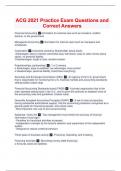Exam (elaborations)
ACG 2021 Practice Exam Questions and Correct Answers
- Module
- Institution
Financial Accounting information for external user such as investors, creditor (banks), or the government Managerial Accounting Information for internal users such as managers and employees. Corporation a business owned by Shareholder (issue stock) -Advantages: easy to transfer ownership (buy/ se...
[Show more]



